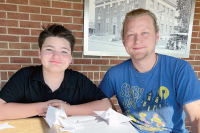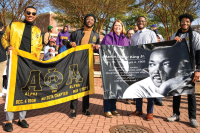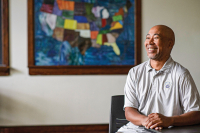Sylva woman shares experience of Chile earthquake
Sylva resident Susannah Patty thought her trip to Chile would be an adventure, but she didn’t count on living through the fifth biggest earthquake of the century.
In her late 20s now and no stranger to travel, Patty says she has a knack for going places the moment “things go bizarre.”
She was in Paris when large-scale riots between police and teenagers broke out on the north side of the city. She was in Cameroon during a political upheaval that paralyzed the country. Then she was in Chile, in a club in the wee hours of the morning celebrating with friends, and the world was shaking.
“There were no screams, only a few who ran outside, and no massively loud noises where I was. I was instructed to hold on, but there was no time to think about where one should go or what one should do,” Patty wrote in a travel log she kept in the days after the quake.
Fortunately, Patty’s host in Chile, Maqui Ortiz, lives in the northern port town of Valparaiso, far from the earthquake’s epicenter near Concepcion. Ortiz was previously living in Chapel Hill when the two met through mutual friends in Asheville.
When Ortiz decided to go back to Chile to explore her roots, Patty jumped at the chance to visit. The quake registered 8.8 on the Richter scale near its epicenter and 7.8 in Valparaiso.
“It was really over before I realized what was happening, but if I could equate the feeling to anything, it would be the strongest turbulence I’ve felt on an airplane,” Patty said after she arrived safely in Sylva on Monday.
Patty speaks French, not Spanish, so she relied on Ortiz and her network of friends to help her get around in Chile. When the quake struck, she’d already been in Valparaiso for six days.
In her journal, she described the town in a way that makes it easier to feel what the quake must have been like there.
“During the day, the vista looks impossible — multi-story houses of all styles and colors built at the turn of the century are perched on cliffs, within a block there are at least ten rooflines, and the labyrinthine roads approach 45 degree angles. At night, which is when the 7.8 earthquake hit, the hills are cloaked with an enigmatic net of yellow lights that cradle the bay.”
The disorientation of being a stranger in a strange land turned on its head for Patty that night. While the terremoto didn’t level Valparaiso, it did damage nearly every building and knocked out its electricity.
“Chileans are used to earthquakes, so when I was with new friends on the second story of a large building and the shocks began, I looked toward faces that were for the most part calm, albeit a bit stunned. Afterwards, I found out that if you look at glasses on the table, you know you will be fine if they rock and sway, indicating a side-to-side motion that is better absorbed by structures. If they rattle up and down, apparently, you know you are dead.”
After the quake, the town’s residents emptied into the darkened streets, and Patty followed the crowd to safety.
“After a minute and a half, the building slowed its rocking; singing and cheering collided, and the lights flickered, going out completely within a few minutes. Once out on the street, following the tambourines of friends, the city no longer existed in a recognizable state. It was not unrecognizable because of destruction — there was minimal damage comparatively — but because the lights had been extinguished.”
Patty described how in the darkness she was led by the hand of a relative stranger to a safe place away from the buildings then to another apartment to sleep. Her host, who had lived through a massive earthquake in 1985, could not sleep.
In the days after the quake, Patty said the people exhibited a combination of joyful gratitude, relief and fear.
“Relief was so entwined with apprehension, about what was to be found, or not, elsewhere, about gas explosions, about tsunamis, about another quake and temblores that there was no way to compartmentalize the emotions or the sensation which was expressed through a remarkable efficiency of action. Tones of angst only came out in retrospective discussions focused on piecing together fragments of information: where individuals were, what it was like, what kind of damage their houses sustained, if and when they had heard from family members in the south and in Santiago,” she wrote.
The plaster walls in the apartment Patty was staying in were damaged, and the shelves emptied by the quake. She and Ortiz didn’t want to stay indoors the day after, so they went to the beach. There wasn’t a soul there except a group of itinerant clowns. All of the boats in the port were stowed away. The emptiness, she said, was terrifying.
She was originally scheduled to return from Chile a week ago, but Chile’s main airport terminal was destroyed by the quake, and the roads connecting Valparaiso to the capital, Santiago, were closed.
Patty stayed with Ortiz and her friends and watched Chile try to get back to normal. She raised $300 online to donate groceries for people who needed food. She watched her friends throw together an impromptu performance of larger than life marionettes to raise spirits. She noticed how the graffiti on the walls turned positive: “Chile ayuda a Chile.” “Chile help Chile.”
In the end, Patty’s journey to Chile opened up a new realm of experience for her. It wasn’t that she was disconnected from the horror Americans saw on the news, it was that she was connected to it in a way that made it harder to compartmentalize.
That message is clear in one of the searching passages of her journal.
“When there is a sudden transformation of the world or our part of it, there also exists a crucial time-space before anyone can gauge the shift or build up a framework of memories and images that situate the extent of the change; in this space, people intuit what is necessary,” she wrote.
But the quake certainly left its mark on Susannah Patty, and her experience of the moment it hit evokes the fates of the people in Concepcion who were not as lucky as she was.
“You instinctively know that for moments, and possibly forever, your situation chooses you, you do not choose it,” she wrote.





